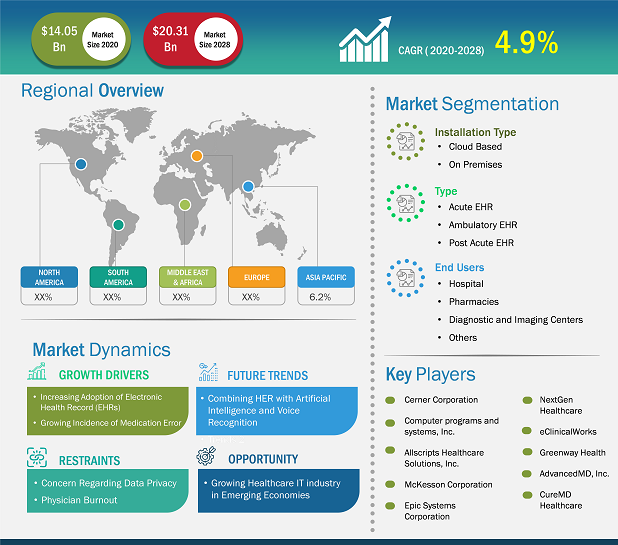$4450
$3560
The electronic health record market size is expected to reach US$ 79.43 billion by 2031 from US$ 40.55 billion in 2024. The market is anticipated to register a CAGR of 10.3% during 2025–2031.
Electronic Health Record Market Analysis
The global electronic health record market has experienced significant growth over the past few years driven by increased digital transformation efforts within healthcare systems, government initiatives, and increased demand for more advanced healthcare infrastructure. Growth is also supported by healthcare information workload and data volume increase, interoperability initiatives, emerging technologies, and overall therapeutic innovation. Investigative companies are investing in innovation to develop EHR solutions that are scalable, mobile, and analytics-based to meet changing clinical and administrative request for data and information. As healthcare agencies make substantial efforts to become more operationally efficient and better engage with patients/families, the electronic health record market is anticipated to grow strong moving into the future.Electronic Health Record Market Overview
Electronic health records (EHRs) are computerized versions of patients' paper charts that contain a real-time, patient-centered record that is accessible all at once and securely to those who have the right access. EHR system exist that allow details for each patient, including a medical history, diagnosis, medications, treatment plans, immunisations dates, and allergies, as well as radiology images and laboratory test results, all to enable more efficient clinical workflows, better coordination of care, and higher quality, safer, and more efficient healthcare. EHRs are in use in hospitals, clinics, specialty care centers, laboratories, and even mobile care units. With increased focus on integrated, patient-centered healthcare experiences and greater pressure for EHRs to enable evidence-based decision-making, and lessen inappropriate medical errors, and ultimately, improve patient outcomes.
Customize Research To Suit Your Requirement
We can optimize and tailor the analysis and scope which is unmet through our standard offerings. This flexibility will help you gain the exact information needed for your business planning and decision making.
Electronic Health Record Market: Strategic Insights

Market Size Value in US$ 33,144.25 million in 2022 Market Size Value by US$ 74,233.46 million by 2030 Growth rate CAGR of 10.6% from 2022 to 2030 Forecast Period 2022-2030 Base Year 2022

Naveen
Have a question?
Naveen will walk you through a 15-minute call to present the report’s content and answer all queries if you have any.
 Speak to Analyst
Electronic Health Record Market Drivers and Opportunities
Speak to Analyst
Electronic Health Record Market Drivers and Opportunities
Customize Research To Suit Your Requirement
We can optimize and tailor the analysis and scope which is unmet through our standard offerings. This flexibility will help you gain the exact information needed for your business planning and decision making.
Electronic Health Record Market: Strategic Insights

| Market Size Value in | US$ 33,144.25 million in 2022 |
| Market Size Value by | US$ 74,233.46 million by 2030 |
| Growth rate | CAGR of 10.6% from 2022 to 2030 |
| Forecast Period | 2022-2030 |
| Base Year | 2022 |

Naveen
Have a question?
Naveen will walk you through a 15-minute call to present the report’s content and answer all queries if you have any.
 Speak to Analyst
Speak to Analyst
Market Drivers:
Increase in Adoption of Digital Health Care Systems
The medical field is increasingly using digital systems to improve the quality of patient interactions with the hope of better patient outcomes and processes. Electronic health records contain data that can be more efficiently managed, readily accessible to healthcare providers, and interoperability amongst care providers will become significantly easier, leading to wide-ranging adoption of systems with increased electronic health records (EHR) capabilities in both developed and developing countries.Government Incentives and Regulation Support
Countries across the world are working to support their providers in the transition to electronic health records through various funding initiatives, regulations and other supportive actions. The regulatory environment in the US has kept pressure on providers to transition to electronic systems. Supporting regulation such as HIPAA protections for data and the HITECH Act, have all incentivized the growth of EHR solutions, while addressing security concerns.Patient-Centered Care Emphasis and Consumer Choice
There is increasing emphasis on the delivery of care that is more individualized. EHR systems are critical to the delivery of patient-centered plans with personalized plans, promoting patient engagement, better communication between providers, and a better and more satisfying experience for the patient.
Market Opportunities:
Integration with Emerging Technologies
Integration of EHRs with artificial intelligence (AI), machine learning (ML) and Internet of Things (IoT) and blockchain is improving accuracy of documentation, predictive analytics, and security. These technologies will allow for automation, intelligent diagnosis, and real-time insight and for healthcare organizations this means significant opportunities to enhance clinical decision making and to improve administrative and operational processes.
Cloud-Based and Mobile EHR Solutions
Cloud and mobile-based EHRs are viable scalable and cost-effective solutions for easy access to patient records at any time. These solutions enable real time data syncing, remote consultations and improved collaboration among providers and meet healthcare organizations' needs to provide flexibility and mobility, especially in post-pandemic delivery of care and overall healthcare infrastructure.
Growth Opportunities in Emerging Economies
With digital healthcare rapidly developing in emerging economies, avenues are emerging for these markets to adopt EHR's. The demand for EHRs in the emerging markets is bolstered by increasing investments in health information technology infrastructure and increasing internet access, which facilitate the realization of national health goals through government digital health programs. Emerging economies present vendors and other market forces with significant growth opportunities to address the needs of their populations, many of whom are unserved by existing care systems.
Market Trends:
AI-Driven Evolution of EHRs in Healthcare Analytics
AI is enhancing EHR by customizing treatment recommendations, forecasting health outcomes, and identifying diseases much earlier than previously possible. By smarter EHR systems, AI can more seamlessly help with the transition to information-based and preventative healthcare by improving clinical processes, decreasing the administrative load, and aiding in clinical decision support.Interoperability and Integrated Health Records
Healthcare systems are prioritizing interoperability across platforms and providers to facilitate seamless data exchange. Integrated health records enable full patient views, coordinated patient care, and minimize duplication. This trend is an important enabler of collaborative care models; it will also help the industry meet regulatory expectations for patient-accessible electronic health information.Value-Based Care Integration
The shift from fee-for-service to value-based care is changing EHR systems from focusing solely on documentation of services to documentation focused on health outcomes, efficiency, and quality of care. EHR systems will need to evolve to support performance metric tracking, documenting patient care coordination, and provide insights that appropriately align with reimbursement models for patient health outcomes.
Electronic Health Record Market Report Segmentation Analysis
The electronic health record market is divided into different segments to give a clearer view of how it works, its growth potential, and the latest trends. Below is the standard segmentation approach used in industry reports:
By Installation Type:
Cloud-Based:
Remote inclusion, simplicity, and cost-effectiveness are the advantages of cloud-based EHR. These solutions work best for smaller and medium-sized clinics and ask for real-time data access.On-Premise:
Larger healthcare organizations with established IT facilities and stringent compliance standards prefer these systems. EHR also allows a system and data protection along with better system and data protection.
By Type:
Acute EHR :
Acute EHR are designed for hospitals and inpatient settings. It support complex, high-acuity care with features such as real-time monitoring, medication management, and emergency interventions.Ambulatory EHR :
It is used for outpatient care settings. It streamlines documentation, patient scheduling, and chronic disease management. It helps to improve workflow efficiency for clinics and physician practices.Post-Acute EHR:
It is used for rehabilitation centers, nursing homes, and long-term care facilities. It helps to manage patient transitions, therapy progress, and extended care documentation.
By Application:
- Clinical Records
- Administrative Task and Billing
- Physician Support
- Patient Portal
This segment includes clinical records, administrative tasks and billing, physician support, and patient portals. Each segment helps with streamlining of healthcare delivery. It improves documentation, enhance billing accuracy, support clinical decisions, and helps to boost patient engagement via secure, real-time access to personal health data.
By Distribution Channel:
- Hospitals and Clinics
- Ambulatory Care Centers
- Physicians' office/Specialty Care Centers
By Geography:
- North America
- Europe
- Asia Pacific
- South & Central America
- Middle East & Africa
Electronic Health Record Market Report ScopeElectronic Health Record Market Share Analysis by Geography
The electronic health record (EHR) market in Asia Pacific is growing. This is mainly due to growing digital healthcare adoption, and growing government support of healthcare IT infrastructure development. Emerging markets in South and Central America, and the Middle East and Africa also provide untapped opportunities for EHR vendors to expand their growth.Market growth will vary by region due to varying healthcare digitization, regulatory mechanisms, and infrastructure development. Below is a summary of market share and trends by region:
1. North America
Market Share:
Holds a dominant share of the global EHR market due to early adoption and advanced healthcare infrastructureKey Drivers:
- Strong presence of major EHR vendors and established healthcare IT systems
- Supportive regulations such as HIPAA
- High digital literacy and patient engagement in healthcare
Trends:
Increasing integration of AI and telehealth with EHR systems to improve care coordination and outcomes
2. Europe
Market Share:
Accounts for a substantial portion of the global EHR market, especially in Western EuropeKey Drivers:
- Government-led digital health initiatives and funding programs
- Rising demand for cross-border healthcare data sharing
- High focus on patient data privacy and GDPR compliance
Trends:
Expansion of cloud-based EHR systems and focus on interoperability across national health systems
3. Asia Pacific
Market Share:
Witnessing the fastest growth rate in the global electronic health record marketKey Drivers:
- Growing investments in healthcare infrastructure and IT in countries such as India, China, and Japan
- Increasing population and chronic disease burden
- Government programs promoting digital health transformation
Trends:
Mobile and cloud EHR adoption in rural and urban areas; rise of telemedicine integration
4. South and Central America
Market Share:
Although small, it is moderately growingKey Drivers:
- Expanding public healthcare systems and regional digitization initiatives
- Need for efficient record-keeping in underserved and remote areas
- Local EHR vendors offering affordable solutions
Trends:
Gradual transition from paper to digital records with growing interest in cloud EHR platforms
5. Middle East and Africa
Market Share:
Holds a smaller share but shows significant potential for future growthKey Drivers:
- Government healthcare modernization plans in the Gulf countries
- Rising demand for efficient health data management in emerging economies
- Increasing investment in hospital infrastructure and smart health systems
Trends:
Adoption of interoperable and multilingual EHR systems to cater to diverse populations
Electronic Health Record Market Players Density: Understanding Its Impact on Business Dynamics
High Market Density and Competition
Competition is intense due to established players such as Oracle Corp, Veradigm Inc, and Infor-Med Inc. Regional and niche providers such as eClinicalWorks LLC (US) and PracticeSuite Inc (US) add to the competitive landscape across regions.
This high level of competition urges companies to stand out by offering:
- Advanced AI-powered analytics and decision support tools
- Secure, interoperable, and patient-centric EHR solutions
Opportunities and Strategic Moves
- Integration of telehealth and mobile health applications with EHRs
- Increasing focus on data privacy, security, and compliance with regulations
Major companies operating in the electronic health record market are:
- Veradigm Inc – Durham, North Carolina, US
- Greenway Health LLC – Tampa, Florida, US
- eClinicalWorks LLC – Westborough, Massachusetts, US
- Infor-Med Inc – Petach Tikva, Israel
- Microwize Technology Inc – New Delhi, India
- Athenahealth Inc – Watertown, Massachusetts, US
- ChipSoft.com Inc – Amsterdam, Netherlands
- AdvancedMD Inc – South Jordan, Utah, US
- PracticeSuite Inc – New Jersey, US
- Oracle Corp – Austin, Texas, US
Disclaimer: The companies listed above are not ranked in any particular order.
Other companies analyzed during the course of research:
- Cerner Corporation
- Allscripts Healthcare Solutions
- MEDITECH
- NextGen Healthcare
- Epic Systems Corporation
- McKesson Corporation
- GE Healthcare
- e-MDs
- Netsmart Technologies
- Kareo
- Practice Fusion
- drchrono
- Advanced Data Systems Corporation (ADSC)
- Medhost
- Sevocity
Electronic Health Record Market News and Recent Developments
Oracle Brings EHR into the 21st Century -
Oracle has launched its all-new, modern Oracle Health EHR for ambulatory providers in the US. This AI-powered, voice-first solution enables clinicians to access patient information effortlessly using voice commands, reducing administrative burden and streamlining workflows. Designed with frontline providers, it enhances care quality. The company plans to include acute care features in this solution by 2026.Campbell County Health Implements Epic EHR -
Campbell County Health (CCH) went live with Epic, a leading Electronic Health Record system, on July 19, 2025. This implementation marks a major advancement in improving patient care, communication, and operational efficiency for the health system.
Electronic Health Record Market Report Coverage and Deliverables
The "Electronic Health Record Market Size and Forecast (2021–2031)" report provides a detailed analysis of the market covering the following areas:
- Electronic health record market size and forecast at global, regional, and country levels for all the key market segments covered under the scope
- Electronic health record market trends, as well as market dynamics such as drivers, restraints, and key opportunities
- Detailed PEST and SWOT analysis
- Electronic health record market analysis covering key market trends, global and regional framework, major players, regulations, and recent market developments
- Industry landscape and competition analysis covering market concentration, heat map analysis, prominent players, and recent developments for the electronic health record market
- Detailed company profiles

Report Coverage
Revenue forecast, Company Analysis, Industry landscape, Growth factors, and Trends

Segment Covered
Installation Type, Type, Application, End User, and Geography

Regional Scope
North America, Europe, Asia Pacific, Middle East & Africa, South & Central America

Country Scope
This text is related
to country scope.
Frequently Asked Questions
The market is primarily driven by:Increase in Adoption of Digital Health Care SystemsThe medical field is increasingly using digital systems to improve the quality of patient interactions with the hope of better patient outcomes and processes. Electronic health records contain data that can be more efficiently managed and readily accessible to healthcare providers, and interoperability amongst care providers will become significantly easier, leading to wide-ranging adoption of systems with increased electronic health record (EHR) capabilities in both developed and developing countries.Government Incentives and Regulation SupportCountries across the world are working to support their providers in the transition to electronic health records through various funding initiatives, regulations, and other supportive actions. The regulatory environment in the US has kept pressure on providers to transition to electronic systems. Supporting regulations such as HIPAA protections for data and the HITECH Act have all incentivized the growth of EHR solutions while addressing security concerns.Patient-Centered Care Emphasis and Consumer ChoiceThere is increasing emphasis on the delivery of care that is more individualized. EHR systems are critical to the delivery of patient-centered plans with personalized plans, promoting patient engagement, better communication between providers, and a better and more satisfying experience for the patient.
One of the major challenges restricting widespread adoption of electronic health records—especially among small and mid-sized healthcare providers—is the substantial initial investment and the complexity involved in integrating EHR systems with existing healthcare infrastructure.
The acute EHR segment is growing rapidly in the EHR market, largely because of the demand for superior healthcare IT products in hospitals and inpatient care facilities. These systems all manage complex workflows, allow real-time patient monitoring, coordinate critical care, and provide efficiencies and superior patient outcomes in acute care.
Key applications of electronic health record systems include:1. Clinical Records: Clinical records allow healthcare providers to maintain accurate, complete patient medical histories, diagnoses, and treatment plans to improve the quality of patient care.2. Administrative Task and Billing: This application helps healthcare providers be organized and eliminates billing errors—improving the revenue cycle process in any health organization.Physician Support: Physician support applications provide assistance to an entire large health practice with creating/gaining standardized clinical recommendations for decision-making, diagnostics, treatment protocols, etc., which supports superior patient outcomes with standard evidence-based care.3. Patient Portal: Patient portals enable patients secure access to their health record, appointments, and direct communication with their healthcare provider to support engagement and self-management through ongoing information and bidirectional access.
As of 2024, the global electronic health record market is valued at approximately USD 40.54 billion. It is projected to reach USD 79.42 billion by 2031, growing at a compound annual growth rate (CAGR) of 10.3% during the forecast period from 2025 to 2031.
As of 2025:Asia Pacific: Growth in the electronic health record market within Asia Pacific is currently driven by large-scale use of digital health available through IT adoption in workforce, expanding health infrastructure, and increased investment across health IT landscape in both developed and emerging economies.North America: Growth in the North America electronic health record market is supported by robust government backing, increased sophistication of health care infrastructure, and growing uptake of AI and interoperability solutions across hospitals, clinics, and ambulatory care units.Europe: The electronic health record market in Europe is driven by a plethora of regulatory drives for electronic records, increased emphasis on patient-centered care, and ongoing projects to modernize healthcare systems through digitization and data integration.
Major players include Oracle Corporation, Epic Systems Corporation, Allscripts Healthcare Solutions, MEDITECH, NextGen Healthcare, McKesson Corporation, eClinicalWorks, Athenahealth, and Practice Fusion.
The List of Companies - Electronic Health Record Market
- McKesson Corp
- NEXTGEN HEALTHCARE INFORMATION SYSTEM, LLC
- eClinicalWorks LLC
- AdvancedMD Inc
- CureMD.com Inc
- Greenway Health LLC
- Oracle Corp
- Veradigm Inc
- ChipSoft BV
- Athenahealth Inc
The Insight Partners performs research in 4 major stages: Data Collection & Secondary Research, Primary Research, Data Analysis and Data Triangulation & Final Review.
- Data Collection and Secondary Research:
As a market research and consulting firm operating from a decade, we have published many reports and advised several clients across the globe. First step for any study will start with an assessment of currently available data and insights from existing reports. Further, historical and current market information is collected from Investor Presentations, Annual Reports, SEC Filings, etc., and other information related to company’s performance and market positioning are gathered from Paid Databases (Factiva, Hoovers, and Reuters) and various other publications available in public domain.
Several associations trade associates, technical forums, institutes, societies and organizations are accessed to gain technical as well as market related insights through their publications such as research papers, blogs and press releases related to the studies are referred to get cues about the market. Further, white papers, journals, magazines, and other news articles published in the last 3 years are scrutinized and analyzed to understand the current market trends.
- Primary Research:
The primarily interview analysis comprise of data obtained from industry participants interview and answers to survey questions gathered by in-house primary team.
For primary research, interviews are conducted with industry experts/CEOs/Marketing Managers/Sales Managers/VPs/Subject Matter Experts from both demand and supply side to get a 360-degree view of the market. The primary team conducts several interviews based on the complexity of the markets to understand the various market trends and dynamics which makes research more credible and precise.
A typical research interview fulfils the following functions:
- Provides first-hand information on the market size, market trends, growth trends, competitive landscape, and outlook
- Validates and strengthens in-house secondary research findings
- Develops the analysis team’s expertise and market understanding
Primary research involves email interactions and telephone interviews for each market, category, segment, and sub-segment across geographies. The participants who typically take part in such a process include, but are not limited to:
- Industry participants: VPs, business development managers, market intelligence managers and national sales managers
- Outside experts: Valuation experts, research analysts and key opinion leaders specializing in the electronics and semiconductor industry.
Below is the breakup of our primary respondents by company, designation, and region:

Once we receive the confirmation from primary research sources or primary respondents, we finalize the base year market estimation and forecast the data as per the macroeconomic and microeconomic factors assessed during data collection.
- Data Analysis:
Once data is validated through both secondary as well as primary respondents, we finalize the market estimations by hypothesis formulation and factor analysis at regional and country level.
- 3.1 Macro-Economic Factor Analysis:
We analyse macroeconomic indicators such the gross domestic product (GDP), increase in the demand for goods and services across industries, technological advancement, regional economic growth, governmental policies, the influence of COVID-19, PEST analysis, and other aspects. This analysis aids in setting benchmarks for various nations/regions and approximating market splits. Additionally, the general trend of the aforementioned components aid in determining the market's development possibilities.
- 3.2 Country Level Data:
Various factors that are especially aligned to the country are taken into account to determine the market size for a certain area and country, including the presence of vendors, such as headquarters and offices, the country's GDP, demand patterns, and industry growth. To comprehend the market dynamics for the nation, a number of growth variables, inhibitors, application areas, and current market trends are researched. The aforementioned elements aid in determining the country's overall market's growth potential.
- 3.3 Company Profile:
The “Table of Contents” is formulated by listing and analyzing more than 25 - 30 companies operating in the market ecosystem across geographies. However, we profile only 10 companies as a standard practice in our syndicate reports. These 10 companies comprise leading, emerging, and regional players. Nonetheless, our analysis is not restricted to the 10 listed companies, we also analyze other companies present in the market to develop a holistic view and understand the prevailing trends. The “Company Profiles” section in the report covers key facts, business description, products & services, financial information, SWOT analysis, and key developments. The financial information presented is extracted from the annual reports and official documents of the publicly listed companies. Upon collecting the information for the sections of respective companies, we verify them via various primary sources and then compile the data in respective company profiles. The company level information helps us in deriving the base number as well as in forecasting the market size.
- 3.4 Developing Base Number:
Aggregation of sales statistics (2020-2022) and macro-economic factor, and other secondary and primary research insights are utilized to arrive at base number and related market shares for 2022. The data gaps are identified in this step and relevant market data is analyzed, collected from paid primary interviews or databases. On finalizing the base year market size, forecasts are developed on the basis of macro-economic, industry and market growth factors and company level analysis.
- Data Triangulation and Final Review:
The market findings and base year market size calculations are validated from supply as well as demand side. Demand side validations are based on macro-economic factor analysis and benchmarks for respective regions and countries. In case of supply side validations, revenues of major companies are estimated (in case not available) based on industry benchmark, approximate number of employees, product portfolio, and primary interviews revenues are gathered. Further revenue from target product/service segment is assessed to avoid overshooting of market statistics. In case of heavy deviations between supply and demand side values, all thes steps are repeated to achieve synchronization.
We follow an iterative model, wherein we share our research findings with Subject Matter Experts (SME’s) and Key Opinion Leaders (KOLs) until consensus view of the market is not formulated – this model negates any drastic deviation in the opinions of experts. Only validated and universally acceptable research findings are quoted in our reports.
We have important check points that we use to validate our research findings – which we call – data triangulation, where we validate the information, we generate from secondary sources with primary interviews and then we re-validate with our internal data bases and Subject matter experts. This comprehensive model enables us to deliver high quality, reliable data in shortest possible time.
Trends and growth analysis reports related to Electronic Health Record Market

Sep 2025
Flight Planning Software Market
Size and Forecast (2021 - 2031), Global and Regional Share, Trend, and Growth Opportunity Analysis Report Coverage: By Component (Software and Services), Deployment (Cloud and On-Premise), Application (Logistics and Cargo, Airport, Private Airlines, Commercial Airlines, Flight School and Training Center, and Military and Defense), and Geography

Sep 2025
Deepfake AI Detection Market
Size and Forecast (2021 - 2031), Global and Regional Share, Trend, and Growth Opportunity Analysis Report Coverage: By Component (Software and Services), Deployment (Cloud and On-Premises), Enterprise Size (Large Enterprises and SMEs), Industry Vertical (Media and Entertainment, BFSI, Government and Politics, Healthcare and Life Sciences, IT and Telecom, Retail and E-Commerce, and Others), and Geography

Sep 2025
Electronic Patient-Reported Outcomes (ePROS) Market
Size and Forecast (2021 - 2031), Global and Regional Share, Trend, and Growth Opportunity Analysis Report Coverage: By Delivery Mode (Cloud Based and On-Premises), Application (Oncology, Respiratory, and Others), End User [Contract Research Organizations (CROs), Pharmaceutical Companies, and Others], and Geography (North America, Europe, Asia Pacific, Middle East & Africa, and South & Central America)

Sep 2025
Travel and Expense Management Software Market
Size and Forecast (2021 - 2031), Global and Regional Share, Trend, and Growth Opportunity Analysis Report Coverage: By Deployment Mode (On-Premise and Cloud), Organization Size (Large Enterprises and Small and Medium Enterprises), Industry (BFSI, IT and Telecom, Manufacturing, Healthcare, Government and Defense, Retail, Transport and Logistics, and Others), and Geography

Sep 2025
Online Exam Proctoring Market
Size and Forecast (2021 - 2031), Global and Regional Share, Trend, and Growth Opportunity Analysis Report Coverage: By Type (Advanced Automated Proctoring, Recorded Proctoring, and Live Online Proctoring), Deployment (Cloud and On-Premises), End User (Educational Institutes, Enterprises, Government, and Online Learning Platforms), and Geography

Sep 2025
Data Center Colocation Market
Size and Forecast (2021 - 2031), Global and Regional Share, Trend, and Growth Opportunity Analysis Report Coverage: By Type (Retail Colocation, Wholesale Colocation, and Hybrid Cloud-based Colocation), Enterprise Size (Large Enterprises and SMEs), Industry Vertical (IT and Telecom, BFSI, Healthcare, Retail, and Others), and Region (North America, Europe, Asia Pacific, Middle East and Africa, and South and Central America)

Sep 2025
Personality Assessment Solution Market
Size and Forecast (2021 - 2031), Global and Regional Share, Trend, and Growth Opportunity Analysis Report Coverage: By Component (Solution and Services), Delivery Model (In-House and Outsourced), Offering (Synchronous and Asynchronous), End-user (Corporate or Enterprise [BFSI, Hospitality, IT and Telecom, Media and Entertainment, Healthcare and Pharmaceutical, and Others]), Academic or Education and Government), and Geography